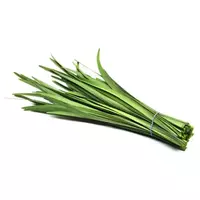Garlic leaves

Garlic is an important agricultural crop that has been cultivated by people for millennia for further culinary use. The herbaceous perennial plant garlic or Allium sativum belongs to the Onion subfamily. The plant is distinguished by its pronounced characteristic garlic taste.
The chemical composition of garlic contains organic thioether sulfides, which determine the characteristic smell of the plant. They eat wedges or, as common people call "cloves, " garlic bulbs. In addition, shoots or garlic leaves, as well as arrows of the plant, are actively used in cooking. The garlic leaves are flat and smooth in appearance.
The color of garlic leaves varies depending on the variety of the plant. As a rule, young garlic leaves have a light green color, which changes over time and becomes darker. In addition, a natural white wax coating can form on the leaves of garlic. It is noteworthy that in cooking they use young garlic leaves, which stand out not only for their pronounced taste and aroma characteristics.
Young shoots or garlic leaves are a real treasure trove of vitamins, donated by nature itself. According to scientific research, young garlic leaves contain a record amount of vitamin C, which plays an important role in maintaining the health of the human body. The uniqueness of garlic leaves lies in the fact that young shoots of the plant are able to create a protective layer around themselves due to the content of phytoncides in the plant.
This protective layer prevents the spread of pests and the occurrence of diseases, thereby protecting plants during growth and development. It is noteworthy that perhaps no plant has such a wide range of applications as garlic. Garlic leaves are actively used in the process of preparing various culinary products.
Vitamin salads, savoury snacks, first and main courses, as well as homemade preservations, use garlic leaves to prepare all these culinary products. Some national culinary traditions of world states are simply unthinkable without garlic. Garlic leaves are especially popular and in demand in Asia, Europe and America, as well as in our vast homeland and countries of the post-Soviet space.
In addition to cooking, garlic leaves have found applications as a means of traditional medicine. regular consumption of young garlic leaves contributes to the normalization of digestive and metabolic processes, helps in the treatment and prevention of diseases of the respiratory system of the human body. In addition, garlic is used as an antibacterial and wound healing agent. Garlic has a positive effect on the cardiovascular system and also improves blood circulation.
garlic leaves 24 kCal
The energy value of garlic leaves (Ratio of proteins, fats, carbohydrates - ju):
Proteins: 1.3 g (~ 5 kCal)
Fats: 0.1 g (~ 1 kCal)
Carbohydrates: 3.4 g (~ 14 kCal)
Energy ratio (bj | y): 22% | 4% | 57%
 Español
Español Français
Français Português
Português Русский
Русский 简体中文
简体中文 繁體中文
繁體中文 日本語
日本語 한국어
한국어 العربية
العربية Türkçe
Türkçe Қазақ
Қазақ Deutsch
Deutsch Italiano
Italiano Українська
Українська
